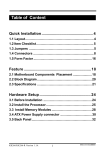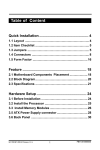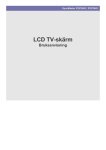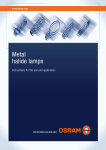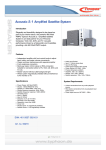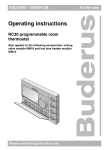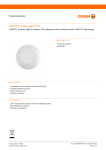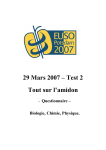Download Philips Lighting TL5 User's Manual
Transcript
Philips ‘TL’5 lamps To the reader This publication is based on the available product range and is intended for use by Original Equipment Manufacturers of luminaires and ballasts, specifiers and other parties in the lighting industry. For your local Philips representative consult the internet site http://www.eur.lighting.philips.com/contacts/contacts.shmtl Please give your feedback, questions and remarks to the Customer Service Desk, Product Management, Philips Lighting, P.O. Box 1109, 4700 BC Roosendaal, the Netherlands. Tel. +31 165 577 566 Fax +31 165 577 760. With that input the content of the next brochure can be further improved. Philips Lighting B.V. reserves the right to change data without prior notification. November 2000. Copyright Philips Lighting B.V. All rights reserved. Reproduction in whole or in part is prohibited without prior permission. Telefax Message To: Customer Service Desk Fax number: +31 165 577 760 Product Management TL/CFL-NI Tel. number: +31 165 577 566 Philips Lighting B.V., Zwaanhoefstraat 2, 4702 LC Roosendaal, the Netherlands From: Company: .................................. Name: ........................................ Fax number: ............................ Street: ......................................... Function: ................................... Tel. number: ............................ City: ........................................... Zip code: ................................... Country: .................................. E-mail: ....................................... Please send me an additional copy (copies) of ‘TL’5 lamps: Product Information for Original Equipment Manufacturers Number of copies: Signature: For your feedback, remarks or questions please contact the Customer Service Desk. Contents 1. General information on Philips ‘TL’5 lamps 1.1 Introduction................................................................................2 1.2 Working principle .....................................................................3 1.2.1 Optimum operation .....................................................3 1.3 Nomenclature ............................................................................4 1.4 Environmental aspects .............................................................4 2. Luminaire design 2.1 2.2 2.3 2.4 Introduction................................................................................5 IEC recommendations .............................................................5 Miniaturization ...........................................................................5 Operating temperatures ‘TL’5 lamps....................................5 2.4.1 Lamp temperatures ......................................................5 2.4.2 Maximum temperatures of lamp parts ....................5 2.4.3 Measuring the lamp cap for optimum lamp conditions .......................................................................5 2.5 Effects of luminaire designon the lamp performance ......5 2.5.1 Cold spot ........................................................................5 2.5.2 Air-handling luminaires.................................................5 2.5.3 ‘TL’5 lamps and cold conditions ................................6 2.5.4 Vertical burning position .............................................6 2.5.5 ‘TL’5 lamps and twin-lampholders ............................6 2.6 General recommendations for handling and measuring ‘TL’5 lamps and luminaires......................................................6 2.7 Lampholder/lamp cap ...............................................................6 2.8 Misuse with ‘TL’5 lamps...........................................................6 2.9 Various applications elements ................................................7 2.9.1 CE marking .....................................................................7 2.9.2 UV radiation...................................................................7 2.9.3 IR radiation .....................................................................7 2.9.4 Explosion risk.................................................................7 2.10Lamp end-blackening ................................................................7 2.11Optical opportunities with ‘TL’5 lamps................................7 4. Operation of ‘TL’5 lamps: Recommendations for ballast design 4.1 Starting characteristics ..........................................................16 4.1.1 Starting conditions......................................................16 4.1.2 Electrode preheating..................................................16 4.1.3 Lamp ignition ...............................................................17 4.1.4 Fast re-ignition.............................................................18 4.2 Dimming....................................................................................18 4.2.1 Electrical properties of the discharge....................18 4.2.2 Conditions for proper operation of the electrodes..............................................................19 4.3 DC operation of ‘TL’5 lamps................................................21 4.4 End-of-life behaviour and asscociated risks......................21 4.5 Lifetime performance.............................................................22 5. Definitions Lighting definitions..................................................................23 Annex 1: International Lamp Coding System ........................24 3. ‘TL’5 lamp specifications 3.1 3.2 3.3 3.4 Range ...........................................................................................9 Mechanical characteristics.......................................................9 Electrical characteristics of ‘TL’5 electrodes ......................9 ‘TL’5 standardization and publication values ......................9 3.4.1 ‘TL’5 HE lamps.............................................................10 3.4.2 ‘TL’5 HO lamps ...........................................................11 3.5 Colour characteristics ...........................................................14 3.6 Spectral power distribution..................................................14 2000-11-07 1 1. General information on Philips ‘TL’5 lamps 1.1 Introduction These features offer in the market the following benefits: ‘TL’5 lamps are fluorescent lamps with a diameter of about 16 mm and are designed to allow system miniaturization. The latest technologies have been incorporated.The tri-phosphor layer in combination with new coating technologies add up to a high lamp efficacy and offer a virtually constant lumen level during lamp life.The lamps have the colour rendering properties of the /800 colours. These lamps meet market demands for energy savings and more freedom of design of luminaires. • Miniaturization The ‘TL’5 HE is a fluorescent lamp range with a diameter of about 16 mm, which is a reduction of 40% compared to the diameter of existing ‘TL’D lamps, having a 26 mm diameter.This smaller dimension gives designers of luminaires more freedom in the design of compact products. The ‘TL’5 range can be split up in two ranges: the ‘TL’5 HE (High Efficiency) and the ‘TL’5 HO (High Output) range. The ‘TL’5 HE range was designed to reach highest efficiency with direct lighting in offices and industry, while still fulfilling required lighting levels.The ‘TL’5 HO range was added for those applications where a higher luminous flux of the lamp can lead to a better lighting effect and/or lower investment. ‘TL’5 lamps are especially designed for operation with electronic gear (High Frequency operation). Because maximum efficacy only is attained with HF operation, 50 Hz operation is not recommended or supported. The luminous flux of ‘TL’5 lamps depends on how the lamps are operated (ballast type/ambient temperature). The ‘TL’5 range consists of the following types: – – – – ‘TL’5 ‘TL’5 ‘TL’5 ‘TL’5 HE HE HE HE 14W 21W 28W 35W (2 (3 (4 (5 ft) ft) ft) ft) – – – – – ‘TL’5 ‘TL’5 ‘TL’5 ‘TL’5 ‘TL’5 HO HO HO HO HO 24W 39W 54W 49W 80W (2 (3 (4 (5 (5 ft) ft) ft) ft) ft) and are available in various colour temperatures, ranging from 2700 K till 6500 K. Features of ‘TL’5 lamp ranges ‘TL’5 lamps are a new generation of fluorescent lamps which enable more compact and efficient systems. The lamps have the following characteristics: • Lamp efficacy up to 104 lm/W for the HE range • A high lumen output of 7000 lm and lamp luminance up to 3,3 cd/cm2 for the HO range (at top lumens) • Narrow diameter lamp of about 16 mm • A virtually constant lumen level during lamp life due to a tri-phosphor layer in combination with new coating technologies • Good colour rendering (/80 colours) • A rated life of 20,000 burning hours (on preheat ballast) • Low mercury dose • Convenient lamp lengths enabling luminaires for easy fitting into ceiling modules • Maximum light output (with optimum ballast) reached at temperatures which are more common in luminaires (35 °C) 2000-11-07 2 • Energy saving In the development of an optimum lighting system the ‘TL’5 HE lamp range has been designed to perform up to 104 lm/W for the lamp.This high gain in efficacy is used to reduce the power consumption of the system, thus leading to an 8% energy reduction compared with a ‘TL’D HF system and as much as 25% energy reduction compared with a ‘TL’D conventional system, both in comparable installations and fulfilling the required lighting levels. • Cost reduction The ‘TL’5 lamps have a high lamp efficacy and a lumen maintenance of about 92% at 10,000 burning hours.This combination means a long economic lifetime and low replacement and maintenance costs. At a 3-hour switching cycle the lamps will have an average rated lifetime of 20,000 burning hours if operated on appropriate HF warm-start ballasts. Moreover, lamp lengths have been defined for easy fitting of the luminaires into the ceiling module system, which means lower installation costs. Due to the miniaturization material costs can be reduced substantially. With the use of ‘TL’5 HO lamps, with a lower lamp efficacy compared with ‘TL’5 HE lamps, considerable savings on investment costs can be reached by its high luminous flux which is up till 90% higher than for comparable HE types. • More attention to the working environment Small dimensions lead to attractive and innovative design and new challenges for luminaire optics. Increased opportunities for using the design are offered by single mounted and suspended luminaires as a marketing element. HF ballasts, principally, make dimming, smooth start and flexible lighting possible, so more comfort for the end-user. • More environmental awareness The high efficiencies of the lamp and electronic ballasts contribute to the environmental awareness by energy saving. Life Cycle Assessment studies show that at least 99% of light sources’ contribution to pollution is caused by their energy consumption during lifetime.The ‘TL’5 lamps contain the /80 New Generation phosphor technology. A spin-off from this technology is a reduction of mercury needed for the lamp to operate efficiently. Also material reduction by miniaturization in the total chain (lamp, ballast, luminaire, packing material, transport costs,stocking costs) and increased life contribute here. Features of electronic ballasts As stated, ‘TL’5 lamps are exclusively designed for HF-operation, resulting in higher lamp efficacies and lower ballast losses, furtheron, compared with conventional gear, an electronic ballast offers the following benefits and features: • Low energy consumption • No flickering lamps • No flicker when switching on the light • Automatic stop-circuit is activitated within five seconds in case of lamp failure (safety stop); once the lamp has been replaced, the ballast resets automatically 1.2 Working principle of the ‘TL’5 lamp A ‘TL’5 lamp is a low-pressure mercury lamp (just like ’TL’D). The tubular fluorescent lamp works on the low-pressure mercury discharge principle. (Fig. 1.1) The discharge tube has an electrode sealed into each end and is filled with an inert gas and a little mercury, the latter being present in both liquid and vapour states. The inner wall of the tube is coated with a mixture of fluorescent powders.These convert the ultraviolet radiation of the mercury discharge into visible radiation (light). Many different fluorescent powders or ‘phosphors’ are available for this purpose, which by judicious mixing can produce light of almost any desired colour temperature and colour rendering characteristic with a high efficacy compared with other light sources producing white light. Visible radiation Ultraviolet radiation Just like all low-pressure mercury lamps ‘TL’5 lamps need a current limiter.The ‘TL’5 lamp especially was designed to operate on an electronic ballast. Because the higher efficacy with ‘TL’5 only is attained with high frequency operation, 50 Hz operation is not recommended or supported. 1.2.1 Optimum operation of ‘TL’5 lamps with cold chamber (cold-spot technology) The luminous flux of a low-pressure mercury vapour lamp is determined by the mercury pressure which on its turn is dependent on the temperature of the coldest spot in the lamp. The maximum light output of the lamp is reached at a cold spot temperature of approx. 45 °C. In case of the ‘TL’5 lamp this cold spot is situated behind the electrode at the stamp side: the so-called cold chamber. (See Figure 1.2) The ‘TL’5 lamp was designed to reach its maximum flux at 35 °C ambient temperature in draught-free air when operated on gear without additional heating of the electrodes. Such a ballast is called a cut-off ballast. 35 °C is the common ambient temperature within luminaires. Any deviation from these nominal conditions for operation will influence the light output of a ‘TL’5 lamp. This can happen: – If the design of the luminaire allows an ambient temperature near the lamp(s) deviating from 35 °C – If the nominal specifications of the gear include a lamp current deviating from the nominal value and/or include heating of the electrodes during operation.The additional power dissipation will heat the spot behind the electrodes and so will result in a shift of the curve of the output of the luminous flux: the top will be reached at lower ambient temperatures, for that reason the use of cut-off ballasts is recommended with ‘TL’5 lamps. For further details about deviation from the normal operation conditions see 2.5. Stamp ;;;;;; ;;;;;; ;;;;;; ;;;;;; ;;;;;; ;;;;;; ;;;;;; ;;;;;; ;;;;;; ;;;;;; ;;;;;; Fluorescent powder Mercury atom Electrons Electrode Figure 1.1: Working principle of a tubular fluorescent lamp Cold spot (within the lamp) Figure 1.2: Lamp end with cold chamber (lamp stamp end) 2000-11-07 3 1.3 Nomenclature The name of the lamp family is: ‘TL’ fluorescent lamps The technical name of the product is: ‘TL’5 5: tube diameter of 5/8 inch 1.4 Environmental aspects Life Cycle Assessment (LCA) studies show that at least 99% of light sources’ contribution to pollution is caused by their energy consumption.This means the higher the efficacy, the better from the environmental (and economical) point of view. Less energy consumption means less energy generation, which will have a positive effect on the environment: reduced fuel consumption results in a reduction of power plant emissions. Example: ‘TL’5 HE 14W /827: ‘TL’5 tubular double-ended lamp High Efficiency range 14Watt /827: Ra>80,Tc of 2700 K ‘TL’5 HO 54W /840: ‘TL’5 tubular double-ended lamp High Output range 54Watt /840: Ra>80,Tc of 4000 K For the ILCOS code of ‘TL’5 lamps see Annex 1. ‘TL’5 HE fluorescent lamps perform up to 104 lm/W. Due to the low lamp power and the low ballast losses (High Frequency operation) the energy consumption is about 25% less than a ‘TL’D system with conventional operation in comparable installations and still fulfilling the required level. The /80 New Generation phosphor technology which is used with ‘TL’5 lamps is a true breakthrough in product development and manufacturing techniques, minimizing the mercury absorption that is the major cause of lumen depreciation. Advanced coating technologies apply a single-layer tri-phosphor coating instead of the formerly used double-layer halophosphor and tri-phosphors. Furthermore, new precoating procedures dramatically reduce mercury absorption in the single-layer tri-phosphor and glass. As a result, down to a minimum of mercury is required inside the lamp, just as with ‘TL’D New Generation lamps. So in respect to environmental effects ‘TL’5 is another step forward. 2000-11-07 4 2. Luminaire design In this chapter, recommendations and data are given to enable an optimal luminaire design. 2.2 IEC Recommendations The general recommendations for luminaire design by IEC are also applicable to ‘TL’5 luminaires. Lamp-related data can be found in IEC 61195. 2.3 Miniaturization The ‘TL’5 lamp with a diameter of about 16 mm is 40% thinner than the existing ‘TL’D lamp which has a diameter of 26 mm.The new lamp fits better in existing ceiling system modules as it is 50 mm shorter.The thin lamp also gives luminaire designers much freedom in redesign of their products, making it easy to build lighting systems which meet customers’ needs, offering reduced dimensions, weight and height. ‘TL’5 lighting systems are very suited for general lighting purposes, like in offices, industry and shops. Luminaires for ‘TL’5 lamps can be made almost half as narrow as existing ‘TL’D luminaires.The small dimensions of the system allow luminaire designers to apply the ‘TL’5 system also in less traditional lighting systems like miniaturized suspended lighting elements and for integration into shop furniture elements. – the dimensions and type of material of the luminaire – the position of the ballast – the degree of ventilation (open, half-open, closed luminaire). A direct relation exists between the light output of the lamp and the temperature of the mercury in the cold spot: at a temperature of the mercury of 45 °C a maximum in light output will be reached. As the cold spot is situated near the metal cap, at stamp side, the temperature of this cap is a good indication of the pressure of the mercury (see Figure 2.1). So for checking the lamp condition the cap temperature (Tcap) can be used: if Tcap ≈ 45 °C in stable condition, the lamp has maximum light output. Relative luminous flux in % 2.1 Introduction 100 50 25 35 55 65 45 Lamp cap temperature in °C Figure 2.1 2.4 Operating temperatures ‘TL’5 lamps 2.4.1 Lamp temperatures 2.5 Effects of luminaire design on the lamp performance Test requirements 2.5.1 Cold spot The data on the ‘TL’5 lamps are based on free burning conditions on a reference circuitry and the lamp should be tested that way also, unless stated otherwise. Special attention is needed for the situation when a “cold spot” is created on the glass tube (due to local air flow, physical contact with metal parts of the luminaire, etc.) This might make the cold chamber, near the lamp cap, obsolete and the thermal behaviour in that case might deviate from the one expected.This phenomenon can be used at very high ambient temperatures: creating a cold spot to bring the lamp in optimum condition. 2.4.2 Maximum temperatures of lamp parts Luminaires for ‘TL’5 lamps must satisfy the general requirements for luminaires as specified by the IEC Publication 60598 and, if applicable, comply with the requirements of local standards.The maximum allowed temperature of the lamp cap is 120 °C, as given in IEC Publication 61195 - Double-capped fluorescent lamps - Safety specifications. 2.4.3 Measuring the lamp cap for optimum lamp conditions ‘TL’5 lamps will reach maximum light output at 35 °C ambient temperature in draught-free air. For a given lamp power and ambient temperature the circumstances within a luminaire are chiefly determined by: 2.5.2 Air-handling luminaires With an ambient temperature within the luminaire of 35 °C in draught-free air, the cold spot will be at about 45 °C and the lamp will be at maximum light output. In that condition an insulating air layer around the lamp is making the 10 °C difference between the ambient air temperature and the lamp cap temperature. If the air is moving around the lamp the mentioned difference is smaller, resulting in lamp fluxes lower than maximum. One solution is to cover the cold spot (lamp cap at lamp stamp end) with an insulating material to reach optimum light output at lower ambient temperatures. 2000-11-07 5 2.5.3 ‘TL’5 lamps and cold conditions If the ambient temperature within the luminaire is lower than the optimum temperature of 35 °C for ‘TL’5 lamps, due to “cold” applications (outdoor, cooling rooms, etc.) One solution is to cover the cold spot with an insulating cap to reach optimum light output. 2.5.4 Vertical burning position As mentioned before the optimum light output with ‘TL’5 lamps is reached at 35 °C in draught-free air with the lamp in horizontal position. If the lamp is operated in vertical position the upper lamp side will be heated to a slightly higher temperature than the lower lamp side. So with vertical burning of the lamp at cool ambient temperatures the stamp side with the cold spot should be in the top. At warm ambient temperatures the stamp side should be at the bottom. 3. For bringing the lamp again in a stable condition burn the lamp on the nominal ballast for 1 hour at 25 ºC and check stability (see Note below) by monitoring the luminous flux. 4. Measure the luminous flux of the lamp with the nominal ballast at 25 ºC. 5. Gently put the lamp and ballast in the luminaire under test (take care that the cold chamber stays as much as possible at the lowest point) and burn the lamp for at least 1 hour at 25 ºC and check stability again by monitoring the luminous flux. 6. Measure the luminous flux of the luminaire at 25 ºC ambient temperature. Note: For an additional check if the lamp is stable one can cool down locally (by air flow, cold spray ........) the cold chamber. If the light output drops fast, following the cooling of the cold chamber, the lamp was stable (i.e. the mercury vapour pressure is controlled by the cold chamber). If this test is performed the lamp has to burn in a stable manner for at least 15 minutes before starting the actual measurement. 2.5.5 ‘TL’5 lamps and twin-lampholders If ’TL’5 lamps are operated in so-called twin-lampholders, the hot spots near the electrodes could influence the burning conditions of the combination too.Therefore for a proper lamp operation it is recommended to mount both lamps with the cold chamber (lamp stamp end) at the same side. If Tamb is low and so the ambient conditions require heating the cold chamber (see 2.5.2, 2.5.3 and 2.5.4) anti-parallel mounting of the lamps could help in that respect. In that case the electrode opposite to the cold chamber of one lamp will heat the cold chamber of the other lamp. 2.6 General recommendations for handling and measuring ‘TL’5 lamps and luminaires • Handling Always handle a ‘TL’5 lamp as much as possible in vertical position, with the stamp at the lowest side: during transport, putting it in a measuring system, putting it in a luminaire, etc. in order to keep the mercury as much as possible in the cold spot. • Measuring luminaires for ‘TL’5 lamps Before measuring the light output ratio of a luminaire the ‘TL’5 lamps should be in stable condition: the liquid mercury must be in the cold chamber.To reach this condition the following steps should be taken: 1. For bringing the lamps in a stable condition season the lamps for approximately 100 hours vertically with the cold chamber (located at stamped side) at the lowest point. 2. When the lamps have been off for more than 12 hours burn the lamp for at least 4 hours in the above described position before measuring. Transport the lamp in vertical position with the cold chamber at the lowest point to the measuring system. Gently put the lamp in the (horizontal) lampholder, taking care that during installing the lamp the cold chamber stays as much as possible at the lowest point. 2000-11-07 6 2.7 Lampholder/lamp cap Lampholders and wiring for ‘TL’5 lamps should be the 500 V rated versions. The existing lampholders for G5 capped lamps are suitable up to 250 volt, which means that the applied voltage must be lower than 250 volt towards earth. As ‘TL’5 lamps are especially designed for operation with electronic gear (High Frequency operation), the voltage may exceed 250 volt under dimming conditions. Several lampholder manufacturers have G5 lampholders in their range which are 500 V marked, which means that voltages up to 500 volt towards earth are allowed. In principle, all requirements relating to G5 type lampholders will be summarized in IEC Publications 60061-2, 60061-4 and 400. G5 lampholders rated for 250 V continuous voltage are not released to operate with ‘TL’5 lamps. 2.8 Misuse with ‘TL’5 lamps According to IEC regulations luminaire/ballast systems should be designed in such a way that cap temperatures exceeding 120 °C are prevented (see also 2.4.2). Replacing ‘TL’5 lamps with the wrong type with the same length will seldom lead to unwanted situations during normal operating conditions. However, accidental exchange of ‘TL’5 lamps with the wrong type in abnormal, high temperature conditions might lead to overheating of the the lamp caps.Therefore for luminaire manufacturers it is advised to mark clearly which lamp the luminaire is aimed for. 2.9 Various application elements 2.11 Optical opportunities with ‘TL’5 lamps 2.9.1 CE Marking The smaller diameter of ‘TL’5 lamps allows substantially down scaling of the optics to obtain smaller luminaires with the same efficiency and light distribution as the original ‘TL’D luminaire as indicated below in Fig. 2.2. This is ideal in cases where the size of the luminaire is more critical than the efficiency. All Philips fluorescent lamps comply with the EU Low Voltage Directive (73/23/EEC) and are therefore CE marked. 2.9.2 UV radiation Fluorescent lamps radiate a very low amount of UV. So this is no issue regarding effects on human eyes and skin. Another effect of UV is the risk of colour fading of the illuminated goods.This fading risk depends on: - the materials used in the illuminated object - the illumination level - the emitted UV of a light source. For ‘TL’5 lamps the UV damage is generally no issue due to very low UV radiation. See the table below. for specific values regarding UV radiation and ‘Dfc’. Colour UV-A UV-B UV-C UV total D/fc µW/lm µW/lm µW/lm µW/lm 28W/827 /830 /835 /840 /850 /865 58,1 50,7 47,8 38,1 33,0 23,5 15,5 11,3 9,0 6,0 4,1 2,1 0 0 0 0 0 0 73,6 62,0 56,8 44,1 37,1 25,6 0,20 0,19 0,19 0,19 0,19 0,20 PET* klx•h 30 39 39 72 92 204 2.9.3 IR radiation In general fluorescent lamps radiate a very low amount of IR radiation. Nevertheless to avoid problems it is recommended not to use remote controls at 36 kHz. 2.9.4 Explosion risk Fluorescent lamps are low-pressure gas-discharge lamps which operate at relatively cool temperatures.These lamps are not subject to specific risks of explosion as known for some types of high pressure lamps and should be regarded in this respect as identical to the well-known ‘TL’D lamps. 2.10 Lamp end-blackening Typical ‘TL’D luminaire Typical ‘TL’5 luminaire Figure 2.2 In luminaires which are already (too) compact for ‘TL’D lamps and hence have a low efficiency, replacing the ‘TL’D lamps by ‘TL’5 lamps will result in less obstruction of the lamp itself in the luminaire which will lead to a higher efficiency as is indicated in Figure 2.3. Original ‘TL’D luminaire Same luminaire with ‘TL’5 Figure 2.3 Another option is to use the smaller lamp diameter to improve the optical control in the same reflector size as for ‘TL’D as shown above.This is particularly valuable if narrow or explicit beams are required e.g. in wall-washing, panel-lighting, high bay lighting, etc. An example of the effect of lamp size on the optical properties in the same reflector (originally designed for ‘TL’D lamps to give rather small light distribution) with ‘TL’5 and ‘TL’D lamps is given in the following table and the resulting light distributions are given in Figures 2.4 and 2.5. A limited degree of lamp blackening during lamp life is normal and unavoidable.The blackening is caused by a thin layer of electrode material deposited during life on the inner wall of the discharge tube. However, accelerated blackening can occur when the gear does not provide the right (pre)heating currents (either too low or too high). 2000-11-07 7 Effects of lamp diameter on beam width and luminaire efficiency Beam width ‘TL’D ‘TL’5 ° ° Reflector 1 2 x 19 (narrow beam) Reflector 2 2 x 27 (medium beam) Max. intensity Efficiency ‘TL’D ‘TL’5 ‘TL’D ‘TL’5 cd cd % % 2 x 12.5 1920 2433 78 82 2 x 20.0 1557 1829 73 80 These results illustrate the effects of a smaller lamp in the same optics: • a 6 to 9% increase in efficiency of the luminaire • a smaller, hence more effective, light distribution • a higher central intensity even when using a 28 W instead of a 32 W lamp Absolute light distribution of a ‘TL’D and a ‘TL’5 lamp in reflector 1. Note the 25% increase of of maximum intensity by use of ‘TL’5 compared with ‘TL’D in the same narrow beam reflector. (cd) (cd) 180° 180° 90° 90° 90° 60° 60° 90° 600 600 60° 60° 1200 1200 1800 1800 2400 30° 30° 30° 2400 Figure 2.4: ‘TL’D 2000-11-07 8 γ γ = 0°/180° γ = 90°/270° Figure 2.5: ‘TL’5 γ 0 0 γ = 0°/180° γ = 90°/270° 30° 3. ‘TL’5 lamp specifications 3.1 Range 3.3 Electrical characteristics of ‘TL’5 electrodes The ‘TL’5 range consists of: – – – – ‘TL’5 ‘TL’5 ‘TL’5 ‘TL’5 HE HE HE HE 14W 21W 28W 35W (2 (3 (4 (5 ft) ft) ft) ft) – – – – – ‘TL’5 ‘TL’5 ‘TL’5 ‘TL’5 ‘TL’5 HO HO HO HO HO 24W 39W 54W 49W 80W (2 (3 (4 (5 (5 Electrodes of ‘TL’5 lamps have been designed to fulfil IEC specifications.The minimum and maximum values for resistances with related test currents are given below. ft) ft) ft) ft) ft) Resistance R of ‘TL’5 electrodes 3.2 Mechanical characteristics For maximum lamp dimensions according to IEC Publication 60081, see table below (Figure 3.1). ∅ 17.0 max. C B A Type A max. B min. B max. C max. ‘TL’5 HE 14W/HO 24W 549,0 553,7 556,1 563,2 ‘TL’5 HE 21W/HO 39W 856,1 863.2 849,0 853,7 ‘TL’5 HE 28W/HO 54W 1149,0 1153,7 1156,1 1163,2 ‘TL’5 HE 35W/HO 49W 1449,0 1453,7 1456,1 1463,2 ‘TL’5 HO 80W 1453,7 1456,1 1463,2 1449,0 Lamp cap: G5 (see IEC Publication 60061-1 sheet 7004-52) Fig. 3.1: Dimensions ‘TL’5 (in mm) ‘TL’5 ‘TL’5 ‘TL’5 ‘TL’5 ‘TL’5 ‘TL’5 HE range HO 24W HO 39W HO 54W HO 49W HO 80W Itest mA rated R Ω min. R Ω max. R Ω 160 350 350 500 260 550 40 12 12 8 16,5 7 30 9 9 6 12,38 5,25 50 15 15 10 20,62 8,75 3.4 ‘TL’5 standardization and publication values ‘TL’5 lamps have been specified and originally standardized to reach the maximum light output at an ambient temperature of 35 ºC.To enable the partners in the business chain to check the luminous flux and the electrical values of the bare lamp at 25 ºC, it is proposed to change the specifications of ‘TL’5 lamps according to IEC Publication 60081 to 25 ºC, without changing the lamp concept. Following this proposal from September 2000 on data for ‘TL’5 lamps will be published as follows – Publication values for design and calculation of installations: luminous flux of ‘TL’5 lamps is equal to the luminous flux at 25 ºC ambient temperature – For ballast and luminaire design the OEM information contains electrical and photometrical values at both an ambient temperature of 25 ºC as well as 35 ºC. The lamps fulfil the safety regulations in accordance with IEC Publication 1195 - Double-capped fluorescent lamps - Safety specifications. The circumscription (inclusive the warp) of the lamps is 17 mm. The nominal diameter of ‘TL’5 lamps is 16 mm. 2000-11-07 9 3.4.1 Electrical and lighting characteristics of ‘TL’5 HE lamps In the following tables the electrical and photometrical data are given: Reference ballast Lamp type Colour Nominal conditions at Tamb. = 25 °C Rated voltage V Calibration current mA Resistance Ω Discharge current mA Lamp voltage V Lamp power W Luminous flux cd/m2 ‘TL’5 HE 14W /827, /830, /835, /840 /850, /865 167 170 500 165 86 ± 10 13,7 1200 1100 ‘TL’5 HE 21W /827, /830, /835, /840 /850, /865 246 170 725 165 129 ± 10 20,7 1900 1750 ‘TL’5 HE 28W /827, /830, /835, /840 /850, /865 329 170 950 170 170 ± 17 27,8 2600 2400 ‘TL’5 HE 35W /827, /830, /835, /840 /865 413 170 1200 170 215 ± 20 34,7 3300 3100 Conditions at top of lumen curve at Tamb. = approx. 35 °C Lamp type Colour Discharge current mA Lamp voltage V Lamp power W Luminous flux lm Luminous efficacy lm/W Luminance cd/m2 ‘TL’5 HE 14W /827, /830, /835, /840 /850, /865 170 82 ± 10 13,7 1350 1250 96 89 1,7 x 104 1,5 x 104 ‘TL’5 HE 21W /827, /830, /835, /840 /865 170 123 ± 10 20,7 2100 1950 100 93 1,7 x 104 1,6 x 104 ‘TL’5 HE 28W /827, /830, /835, /840 /850, /865 170 167 ± 17 27,8 2900 2700 104 96 1,7 x 104 1,6 x 104 ‘TL’5 HE 35W /827, /830, /835, /840 /865 170 209 ± 20 34,7 3650 3400 104 97 1,7 x 104 1,6 x 104 Note: 1) Data after 100 operating hours. Measuring conditions: • Position: free burning, horizontal position • Operating frequency = 25 kHz • In a reference circuitry according to IEC standardization 2000-11-07 10 In the following table the dependency on the discharge current is given at top of the lumen curve. Luminous flux and efficacy in the table below are only applicable for colours /827, /830, /835 and /840. For colours /850 and /865 the ratio is in line with the preceding table. Lamp type Discharge current mA Lamp voltage V Lamp power W Luminous flux lm Luminous efficacy lm/W ‘TL’5 HE 14W 130 170 220 89 82 78 11 13,7 17 1140 1350 1590 104 96 94 ‘TL’5 HE 21W 130 170 220 132 123 116 17 20,7 25 1770 2100 2470 104 100 99 ‘TL’5 HE 28W 130 170 220 178 167 156 23 27,8 34 2440 2900 3410 106 104 100 ‘TL’5 HE 35W 130 170 220 220 209 192 28 34,7 42 3070 3650 4290 110 104 102 Note: 1) Data after 100 operating hours. 2) A discharge current less than the lowest value given for each lamp type will have a negative effect on lamp life unless extra electrode heating is used to keep the electrode at a sufficiently high temperature. 3) A discharge current of more than the highest value given for each lamp type will have a negative effect on lamp life. 4) The bold printed values correspond with the nominal lighting characteristics 5) Data at 35 ºC ambient temperature. 2000-11-07 11 3.4.2 Electrical and lighting characteristics of ‘TL’5 HO lamps In the following tables the electrical and photometrical data are given: Reference ballast Lamp type Colour Nominal conditions at Tamb. = 25 °C Rated voltage V Calibration current mA Resistance Ω Discharge current mA Lamp voltage V Lamp power W Luminous flux cd/m2 ‘TL’5 HO 24W /827, /830, /840 /850, /865 150 300 250 295 77 ± 8 22,5 1750 1650 ‘TL’5 HO 39W /827, /830, /840 /850, /865 224 340 330 325 117 ± 10 38,0 3100 2950 ‘TL’5 HO 54W /827, /830, /840 /850, /865 235 460 255 450 121 ± 10 53,8 4450 4250 ‘TL’5 HO 49W /827, /830, /840 /865 390 255 765 250 200 ± 20 49,3 4300 4100 ‘TL’5 HO 80W /830, /840 /865 290 552 260 540 151 ± 15 80,0 6150 5850 Conditions at top of lumen curve at Tamb. = approx. 35 °C Lamp type Colour Discharge current mA Lamp voltage V Lamp power W Luminous flux lm Luminous efficacy lm/W Luminance cd/m2 ‘TL’5 HO 24W /827, /830, /840, /850 /865 300 75 ± 8 22,5 2000 1900 89 84 2,5 x 104 2,4 x 104 ‘TL’5 HO 39W /827, /830, /840 /865 340 112 ± 10 38,0 3500 3300 92 87 2,8 x 104 2,7 x 104 ‘TL’5 HO 54W /827, /830, /840, /850 /865 460 118 ± 10 53,8 5000 4750 93 88 2,9 x 104 2,8 x 104 ‘TL’5 HO 49W /827, /830, /840 /865 260 191 ± 20 49,3 4900 4650 99 94 2,3 x 104 2,2 x 104 ‘TL’5 HO 80W /830, /840 /865 555 145 ± 15 80,0 7000 6650 88 83 3,3 x 104 3,1 x 104 Note: 1) Data after 100 operating hours. Measuring conditions: • Position: free burning, horizontal position • Operating frequency = 25 kHz • In a reference circuitry according to IEC standardization 2000-11-07 12 In the following table the dependency on the discharge current is given at top of the lumen curve. Luminous flux and efficacy in the table below are only applicable for colours /827, /830 and /840. For other colours these values are in line with the preceding table. Lamp type Discharge current mA Lamp voltage V Lamp power W Luminous flux lm Luminous efficacy lm/W ‘TL’5 HO 24W 270 300 435 78 75 70 21 22,5 30 1830 1950 2410 87 87 80 ‘TL’5 HO 39W 270 340 435 119 112 106 32 38 46 3020 3500 3970 94 92 86 ‘TL’5 HO 54W 370 455 625 125 118 110 46 53,8 68 4400 5000 5900 96 93 87 ‘TL’5 HO 49W 180 255 295 209 191 184 38 49,3 55 3970 4930 5370 104 100 98 ‘TL’5 HO 80W 295 555 600 188 145 142 55 80 85 5370 7000 7330 98 88 86 ‘ Note: 1) Data after 100 operating hours. 2) A discharge current less than the lowest value given for each lamp type will have a negative effect on lamp life unless extra electrode heating is used to keep the electrode at a sufficiently high temperature. 3) A discharge current of more than the highest value given for each lamp type will have a negative effect on lamp life. 4) The bold printed values correspond with the nominal lighting characteristics 5) Data at 35 ºC ambient temperature. 2000-11-07 13 General colour rendering index (Ra): ≥80 Correlated colour temperatures: 2700 K (/827, incandescent) 4000 K (/840, cool white) 3000 K (/830, warm white) 5000 K (/850, daylight) 3500 K (/835, white 3500) 6500 K (/865, cool daylight) Chromaticity coordinates: x y /827 /830 /835 /840 /850 /865 0,469 0,419 0,438 0,403 0,409 0,397 0,381 0,379 0,343 0,353 0,316 0,336 µW per 5 nm per lumen 3.5 Colour characteristics R a ≥ 80 500 400 300 200 100 0 400 500 600 700 Wavelength in nm Note: Chromaticity coordinates at 35 ªC ambient temperature (design temperature). At 25 ªC ambient temperature the chromaticity coordinates will differ slightly from the above values because of the effect of the changing mercury pressure with the ambient temperature. 3.6 Spectral power distribution R a ≥ 80 500 400 300 200 100 400 500 600 700 Wavelength in nm Figure 3.5 Spectral power distribution: colour /840 400 300 200 100 0 400 500 600 700 Wavelength in nm Figure 3.2 Spectral power distribution: colour /827 R a ≥ 80 500 400 300 200 100 0 400 500 600 R a ≥ 80 500 700 Wavelength in nm Figure 3.6 Spectral power distribution: colour /850 400 300 200 100 0 400 500 600 700 Wavelength in nm Figure 3.3 Spectral power distribution: colour /830 µW per 5 nm per lumen µW per 5 nm per lumen R a ≥ 80 500 0 µW per 5 nm per lumen µW per 5 nm per lumen The normalized spectral power distribution of a ‘TL’5 lamp is given in the following diagrams. For UV radiation see the table in section 2.9.2. µW per 5 nm per lumen Figure 3.4 Spectral power distribution: colour /835 R a ≥ 80 500 400 300 200 100 0 400 500 600 700 Wavelength in nm Figure 3.7 Spectral power distribution: colour /865 2000-11-07 14 2000-11-07 15 4. Operation of ‘TL’5 lamps: Recommendations for ballast design 4.1 Starting characteristics Current controlled preheating 4.1.1 Starting conditions Depending on the available time for preheating, the ballasts should give a preheating current within the following limits: Like all fluorescent lamps, ‘TL’5 lamps have electrodes with some emissive material facilitating ignition, provided it is heated to a sufficiently high temperature. The best way of starting a ‘TL’5 lamp is to preheat the electrodes to this high temperature prior to raising the open circuit voltage to values that will cause an ignition. The following information is intended to help electronic ballast manufacturers in finding their way to design ballasts with maximum performance. It is to be read in conjunction with IEC Publication 60929: “A.C. supplied electronic ballasts for tubular fluorescent lamps. Performance requirements.” 4.1.2 Electrode preheating In this section information regarding the preheating process is given. However, some changes are to be expected in 2000. Within IEC, the lighting industry is finalizing discussions regarding standardization of preheating values of ‘TL’ lamps. Two basic methods of providing preheated cathodes at lamp starting are normally used, these being either: 1. cathode current controlled preheating 2. cathode voltage controlled preheating Preheating circuits, which are not of the pure current controlled or the pure voltage controlled type can be described by the energy which should be supplied to the cathode: Cathode energy controlled preheating Preheating information is given by the energy requirement, calculated by the formula: E = Q + P x t, measured in a substitution resistor Rsub. This formula shows that the energy required, is the sum of the energy supplied into the electrodes (heat content) and the power lost (heat loss) by the electrodes during preheating time. The following tables include minimum and maximum preheating data for ‘TL’5 lamp electrodes at five different preheating times: 0,5 s, 1 s, 1,5 s, 2 s and 3 s. Some preceding remarks: 1) preheating times < 0.4 s have to be discouraged 2) preheating currents at non-mentioned times can be calculated by the use of the energy formula 3) the values given are steady state values (constant during preheating time) 4) frequent use of preheating outside the mentioned limits will cause accelerated end-blackening and will have a negative effect on lamp life. 2000-11-07 16 Lamp type Preheating current mA ‘TL’5 HE min. (r.m.s.) max. (r.m.s.) ‘TL’5 HO 24W min. (r.m.s.) max. (r.m.s.) 39W min. (r.m.s.) max. (r.m.s.) 54W min. (r.m.s.) max. (r.m.s.) 49W min. (r.m.s.) max. (r.m.s.) 80W min. (r.m.s) max. (r.m.s.) Preheating time Substitution resistor 0,5 s 1,0 s 1,5 s 2,0 s 3,0 s (Rsub) 290 400 700 1175 700 1175 1090 1370 490 570 1160 1365 235 350 215 300 550 485 1000 825 550 485 1000 825 860 770 1210 1055 370 320 490 410 905 815 1210 1055 200 190 250 250 450 650 450 650 720 900 295 330 765 900 415 650 415 650 665 900 265 330 705 900 40 Ω 40 Ω 12 12 12 12 8 8 16,5 16,5 7 7 Ω Ω Ω Ω Ω Ω Ω Ω Ω Ω Voltage controlled preheating Depending on the available time for preheating, the ballasts should give a preheating voltage within the following limits: Provisional data Lamp type Preheating voltage V ‘TL’5 HE min. (r.m.s.) max. (r.m.s.) ‘TL’5 HO 24W min. (r.m.s.) max. (r.m.s.) 39W min. (r.m.s.) max. (r.m.s.) 54W min. (r.m.s.) max. (r.m.s.) 49W min. (r.m.s.) max. (r.m.s.) 80W min. (r.m.s) max. (r.m.s.) Preheating time Substitution resistor 0,5 s 1,0 s 1,5 s 2,0 s 3,0 s (Rsub) 9,1 12,9 7,4 10,4 6,7 9,4 6,3 8,9 5,9 8,3 31,0 Ω 31,0 Ω 5,7 8,0 5,7 8,0 5,9 8,3 6,6 9,4 5,4 7,6 4,5 6,4 4,5 6,4 4,6 6,5 5,2 7,4 4,1 5,8 4,1 5,8 4,1 5,8 4,0 5,7 4,7 6,6 3,6 5,1 3,8 5,4 3,8 5,4 3,7 5,3 4,3 6,1 3,3 4,7 3,6 5,1 3,6 5,1 3,4 4,8 4,0 5,7 3,0 4,2 8,2 8,2 8,2 8,2 5,1 5,1 13,0 13,0 4,5 4,5 Ω Ω Ω Ω Ω Ω Ω Ω Ω Ω Energy controlled preheating 4.1.3 Lamp ignition Depending on the available time for preheating, the ballasts should give a preheating energy within the following limits: E=Q+Pxt Lamp type Preheating Preheating time energy J 0,5 s 1,0 s 1,5 s 2,0 s 3,0 s ‘TL’5 HE min. max. 1,35 1,75 2,15 2,70 3,50 4,30 min. max. min. max. min. max. min. max. min. max. 1,95 3,90 1,95 3,90 3,40 6,80 1,70 3,40 3,25 6,50 Q J Substitution P resistor W (Rsub) 2,55 3,35 0,95 0,8 5,10 6,70 0,95 0,8 31,0 Ω 31,0 Ω ‘TL’5 HO 24W 39W 54W 49W 80W 2,50 5,00 2,50 5,00 4,10 8,20 2,10 4,20 3,80 7,60 3,05 3,60 4,7 6,10 7,20 9,4 3,05 3,60 4,7 6,10 7,20 9,4 4,80 5,50 6,9 9,60 11,00 13,8 2,50 2,90 3,7 5,00 5,80 7,4 4,35 4,90 6,0 8,70 9,80 12,0 1,40 1,40 1,40 1,40 2,70 2,70 1,30 1,30 2,70 2,70 1,1 1,1 1,1 1,1 1,4 1,4 0,8 0,8 1,1 1,1 8,2 8,2 8,2 8,2 5,1 5,1 13,0 13,0 4,5 4,5 Ω Ω Ω Ω Ω Ω Ω Ω Ω Ω Ignition with preheating. The following table includes values for the open-circuit voltages, which an electronic ballast should generate for two different ranges of ambient temperatures (indoors and outdoors). Lamp type Voltage V ‘TL’5 HE 14W min. (r.m.s.) max.(r.m.s.) 21W min. (r.m.s.) max.(r.m.s.) 28W min. (r.m.s.) max.(r.m.s.) 35W min. (r.m.s.) max.(r.m.s.) ‘TL’5 HO 24W min. (r.m.s.) max.(r.m.s.) 39W min. (r.m.s.) max.(r.m.s.) 54W min. (r.m.s.) max.(r.m.s.) 49W min. (r.m.s.) max.(r.m.s.) 80W min. (r.m.s.) max.(r.m.s.) During Ignition at Ignition at Substitution preheating 10 to 60 °C -15 to 60 °C resistor (Rsub) 230 275 340 390 425 530 530 700 280 350 350 390 520 620 450 625 580 750 130 200 240 275 130 175 240 225 250 40,0 40,0 40,0 40,0 40,0 40,0 40,0 40,0 Ω Ω Ω Ω Ω Ω Ω Ω 12,0 12,0 12,0 12,0 8,0 8,0 16,5 16,5 7,0 7,0 Ω Ω Ω Ω Ω Ω Ω Ω Ω Ω Note: The open-circuit voltages are valid for: - sinusoidal voltages (crest factor 1,4), frequency 20 - 26 kHz, - applications with an earthed plate at a distance of 6 mm, - properly preheated coils. Ignition without preheating: cold ignition The published lifetime of a lamp is based on a switching cycle of 165 minutes on and 15 minutes off with preheated coils, which is considered as representative for general lighting applications. However, the ‘TL’5 lamps can be ignited without preheating.This will lead to more damage to the coil during the ignition phase. For this reason, we do not recommend cold ignition with frequent switching. However, cold ignition can be an option for not frequently switched lamps, like lamps burning for at least 8 hours per switch. More information on the dependency of lifetime on preheating conditions and switching cycle can be found in the separate brochure “Life expectancy, lumen maintenance and service life curves of Fluorescent lamps (‘TL’ and CFL-NI)” 3222 635 18911. 2000-11-07 17 Cold ignition requires a higher ignition voltage.The minimum required ignition voltage can be found in the table below. It is advisable that the lamp current directly after ignition is at least equal to the nominal lamp current.This reduces the time that the lamp is burning with a cold cathode thus the damage to the coil. 4.2 Dimming Minimum required ignition voltage for cold ignition: For ensuring the proper operation of ‘TL’5 lamps in dimming conditions, the conditions described in the following two sections should be fulfilled. Please note that fluorescent lamps when dimmed will experience a colour shift. Lamp type ‘TL’5 HE 14W 21W 28W 35W Minimum voltage V Lamp type ‘TL’5 HO Minimum voltage V 560 600 650 800 24W 39W 49W 54W 80W 560 600 800 800 800 4.1.4 Fast re-ignition Normal ignition is specified for -15 °C< Tamb< 60 °C. In this condition the cold spot temperature, and so the temperature of the mercury during ignition, are both at Tambient : THg = Tamb . During operation of the lamp Tambient will increase. Furtheron the mercury temperature (Tcold spot) is about 10 °C higher than Tambient. So THg = Tamb + ~ 10 °C. So for fast re-ignition after a period of operation also a higher Vignition related with t his higher mercury temperature must be applied. If the lamp is operated at very high ambient temperatures (Tamb > 60 °C) with fast re-ignition the mercury temperature might be higher than the maximum specified in the previous table. In these circumstances fast re-ignition within the range of Vign is not guaranteed. Here either an increased Vignition or waiting a short time, until Tcold spot has been decreased, are the alternatives. 2000-11-07 18 Dimming can be defined as the reduction of the luminous flux of a lamp, either continuously or in steps, by reducing the operating current. 4.2.1 Electrical properties of the discharge Dimming is done by reducing the discharge current flowing through the lamp. At lower lamp currents, the lamp voltage will increase (see section 3.4 for the relationship between lamp voltage and current at 35 °C ambient temperature).The lamp voltage is not only dependent on the lamp current, but also on the mercury vapour pressure in the lamp. Under equilibrium conditions the mercury vapour pressure is controlled by the temperature of the coldest spot inside the lamp.Therefore the values of lamp voltage and light output also depend on the temperature of the air immediately surrounding the lamp and also on the burning position of the lamp (see section 2.5). Under High Frequency conditions with sinusoidal discharge current, the lamp voltage will be sinusoidal as well.The lamp power can thus be estimated with considerable accuracy using the product of lamp current and lamp voltage. 4.2.2 Conditions for proper operation of the electrodes For ‘TL’5 HE range: Electrodes in ‘TL’5 lamps consist of a coiled construction of tungsten wire which is filled with emissive material.The lifetime of a fluorescent lamp is determined by the lifetime of the electrode. In order to ensure sufficient electrode lifetime, its temperature should be kept within certain limits. Above a certain temperature the electrodes will be too hot, leading to enhanced evaporation of the emissive material and severe end-blackening. Below a certain temperature the electrode is too cold and sputtering of the emitter occurs.This may lead to extremely short life of the lamp. If ‘TL’5 lamps are dimmed by reducing the lamp current, the power dissipation in the electrodes will decrease, resulting in a lower temperature of the electrode.Thus, in general, additional heating should be supplied to the electrode to maintain its proper temperature. The temperature of an electrode is primarily influenced by three currents. A simplified diagram of electrode currents is depicted in figure 4.4.2. to be published Figure 4.2.3: “target setting” curve ‘TL’5 HE range ILH Note: Also the requirement ILL max.=165 mA should be met. ID ILH = Lead-High (“total”) current ID = lamp (discharge) current ILL = Lead-Low (“heating”) current Normal operation Dimming operation ID ILL ILH 130 - 205 mA 15 - 130 mA < 165 mA < 165 mA 130 - 240 mA 140 - 240 mA ILL The currents ILH and ILL can be measured with a current probe around the lead-in wire. By definition the higher of the two currents is called ILH , the lower of currents ILL. If the two lead-in wires are taken together through one current probe, one measures the lamp current ID. Electrodes in ‘TL’5 lamps are designed in such a way that the lamp current can be varied around its rated value within certain limits. Within these limits of the lamp current, additional heating is not strictly required. If, however, the ballast does supply an additional heating current, the currents in the lead-in wires (ILH and ILL) should be kept within the limits given in the tables on the following pages (Normal operation). If the lamp current is to be dimmed over a broader range, additional heating should be supplied to the electrode for it to maintain its optimum temperature. Also in this case the currents in the lead-in wires should be kept within limits (Dimming operation). Best lifetime and minimum end-blackening of the lamp is obtained when the “target setting” for ILH and ID is observed during dimming (see figures 4.2.3 - 4.2.6).With this “target setting” (relationship between lamp current and Lead-High current), the electrode will have its optimum temperature. For ‘TL’5 HO 24W and 39W: ILH - Lead-High current (mA) Figure 4.2.2: Lamp electrode 500 g T settin TARGE 400 300 200 100 0 0 100 200 300 400 500 ID - Lamp current (mA) Figure 4.2.4: “target setting” curve ‘TL’5 HO 24W and 39W Note: Also the requirement ILL max.=350 mA should be met. Normal operation Dimming operation ID ILL ILH 270 - 435 mA 30 - 270 mA < 365 mA < 365 mA 270 - 450 mA 310 - 450 mA 2000-11-07 19 For ‘TL’5 HO 54W: For ‘TL’5 HO 80W: to be published to be published Figure 4.2.5: “target setting” curve ‘TL’5 HO 54W Figure 4.2.7: “target setting” curve ‘TL’5 HO 80W Note: Also the requirement ILL max.=490 mA should be met. Note: Also the requirement ILL max.=240 mA should be met. Normal operation Dimming operation ID ILL ILH 370 - 625 mA 50 - 450 mA < 525 mA < 525 mA 370 - 650 mA 450 - 650 mA Normal operation Dimming operation ID ILL ILH 440 - 715 mA 55 - 440 mA < 575 mA < 575 mA 440 - 770 mA 480 - 770 mA For ‘TL’5 HO 49W: to be published Figure 4.2.6: “target setting” curve ‘TL’5 HO 49W Note: Also the requirement ILL max.=240 mA should be met. Normal operation Dimming operation 2000-11-07 20 ID ILL ILH 180 - 320 mA 25 - 180 mA < 270 mA < 270 mA 180 - 330 mA 230 - 330 mA Regarding the figures and the preceding tables the following remarks should be made: 1) The actual data given in this Product Information brochure is also the subject of discussion in a working group of ELMAPS (European Lamp Manufacturers Association for the Preparing of Standards).This will result in due time in new data in the relevant IEC standards.Therefore the data given here should be considered as preliminary. 2) If the lamp current (ID) is varied between the limits given at normal operation, additional heating is optional, but not strictly required. 3) In addition to the relation between the lamp current and the Lead-High current, the Lead-Low current (ILL) may have any value < ILL max.The maximum allowed values for the Lead-Low current are given in the tables. Lead-Low currents > ILL max. will cause accelerated end-blackening. 4) It will be clear that practical lamp - ballast combinations will have settings deviating from the ideal “target setting” curve. The grey area in the graph indicates the “acceptable” range of deviation. It is difficult to indicate quantitatively the effects on lamp life for settings deviating from the “target setting”. It is generally observed that higher values of the Lead High current (ILH) lead to strong end-blackening. If the Lead-High current is below the “target setting” the electrode becomes too cold and sputtering of the emitter may occur. If the Lead High current is reduced below the grey area, a short life of the lamp will occur. 5) The data given for the additional heating by means of the LeadHigh current is directly related to the lamp current. Ballasts which do not make use of this direct relation, should be tested in all practical lamp operating conditions. 6) Information is only given for dimming to 10% of the rated value of the lamp current. It is observed that, at lower dimming levels, the temperature profile of the electrode is different from the one at higher lamp currents.Therefore the rules that determine the required extra heating at dimming levels > 10% cannot be extrapolated to lower “deep dimming” levels.The rules that determine low dimming are still under study. However Philips, as well as other manufacturers of electronic gear, already bring ballasts to the market which permit deep dimming. Since no general rules can be given as yet, extensive life testing should be done with those lamp-ballasts combinations. For Philips dimming ballasts, the combination with Philips lamps was extensively tested and released to the market. 4.3 DC operation of ‘TL’5 lamps With DC operation of fluorescent lamps the current is flowing in one direction.The positive mercury ions are transported to the negative cathode.This might lead to the situation that all mercury will disappear from the discharge area near the anode, leaving that part of the lamp red burning. For this reason DC operation of ‘TL’5 lamps during longer periods must be avoided, especially when the non-stamp side, opposite of the cold chamber, is anode (red burning will occur rather quickly as not much mercury is present near the anode). 4.4 Especially under HF conditions the discharge is easier maintained, because no high re-ignition voltages occur as for 50/60 Hz operation.The extra power in the cathode fall region may lead again to strong overheating of the cap and its surroun dings, i.e. the glass and the lampholder. So the ballast should limit the power in the cathode fall to a safe level, or switch-off. 3) The lamp operates, but with both cathodes deactivated or broken. In the above case of rectification, the ballast does not have to switch off, but might limit the power in the cathode region, for instance by sensing the asymmetric in the voltage.The lamp then continues to operate. After some time also the emitter of the other cathode will become depleted. Now on both sides an increased cathode fall is present.The situation is symmetric again, with a higher lamp voltage. If the ballast senses asymmetric only and does not switch-off, it may return to ‘normal’ operation, with extra local power dissipation in both cathode falls. Again this will lead to overheating of the cathode regions. So the ballast should switch off at too high values of the lamp voltage or limit the power. 4) The lamp operates, but with a strongly increased lamp voltage. The lamp voltage may also increase by slow leak-in of impurities. If the ballast is capable of sustaining the discharge, with for instance a constant current, the lamp wattage will increase symmetrically together with the voltage.This higher lamp power is not localized as above, but may still lead to overheating of the lamp and parts of the system. So the ballast should switch off at too high values of the lamp voltage, or limit the power it can deliver to the lamp. End-of-life behaviour and associated risks The following four possible situations can be identified, and should be taken into account by ballast designers: 1) The lamp does not start but both electrodes are intact. If, for whatever reason, the lamp does not start, the ballast may continue to supply the preheating current to the electrodes. This may cause overheating of the lamp cap. Ballast and luminaires should take care of maximum preheating currents (see section 4.2.2), and IEC requirements on maximum current in any lead, and maximum lamp cap temperature (see section 2.4.2) to avoid this overheating. 2) The lamp operates, but one of the electrodes is de-activated or broken. The normal end-of-life situation for fluorescent lamps is emitter depletion of one of the electrodes. In most cases the discharge will extinguish and the lamp will not start again, i.e. the above situation arises. However, if the ballast is capable of sustaining the discharge, a new condition arises. Because of the absence of emitter material the voltage drop at cathode will rise sharply, resulting in an extra power dissipation. It is concentrated in a very small region in front of this electrode and is highly asymmetric. It only occurs in that half phase when the depleted electrode has to act as cathode and emits electrons.The same applies when the cathode breaks and a lead wire acts as cathode. 2000-11-07 21 4.5 Lifetime performance Survivals in % If the ‘TL’5 lamps are operated on electronic gear, designed according to the specifications mentioned in this documentation, at a 3-hour switching cycle (165 minutes on, 15 minutes off), the lamps will have a rated average lifetime of 20,000 burning hours. Operating cycle time min 100 90 690 165 90 45 80 70 Typical values: 5000 hrs: 99% 60 10000 hrs: 98% 50 5000 0 10000 15000 20000 Operating hours Lumen in % Figure 4.4.1 Life expectancy with a 3-hr switching cycle 100 90 80 70 Typical values: 60 5000 hrs: 94% 50 10000 hrs: 92% 15000 hrs: 90% 0 5000 10000 15000 20000 Operating hours Figure 4.4.2 Lumen maintenance Notes on life expectancy curves: Lamp lifetime is specified as the total number of actual operating hours under specific operating conditions. Philips ‘TL’5 lamps are designed for operating with proper preheated electrodes before lamp ignition is established and in accordance with IEC 60901.This is to ensure also reliable long life when the switching frequency is higher than the standard IEC cycle (165 minutes on, 15 minutes off). The published curves give typical average values based on measurements made by Philips Quality Department Lighting based on large production batches of lamps and tested under laboratory conditions in accordance with IEC 60901. In practice, the performance of individual lamps or groups of lamps may vary from the average. Lamps are tested in conjunction with commercially available preheat control gear (ballasts). The rated average lamp life is the expected time at which 50% of any large number of lamps reach the end of their individual lives. Actual operating conditions deviate in most cases from the applied test conditions.The differences can have a significant influence on lamp performance. 2000-11-07 22 Switching cycle effects The rated average lamp life of ‘TL’5 lamps is negatively affected when the switching frequency is higher than the IEC cycle (165 minutes on, 15 minutes off). The table below gives an indication of the relation between the amount of switching and the lamp life. on, 30 on, 15 on, 15 on, 15 Lamp life off off off off 115% 100% 90% 80% Note: Lifetime figures depend on ballast type. In practice lifetimes can deviate. 6. Definitions Lighting definitions Colour rendering Effect of an illuminant on the colour appearance of objects by conscious or subconscious comparison with their colour appearance under a reference illuminant. Colour rendering index (R) Measure of the degree to which the psychophysical colour of an object illuminated by the test illuminant conforms to that of the same object illuminated by the reference illuminant, suitable allowance having been made for the state of chromatic adaptation. Colour rendering index, CIE 1974 general (Ra) Mean of the CIE 1974 special colour rendering indices for a specified set of eight test colour samples. Colour temperature The temperature of a Planckian radiator whose radiation has the same chromaticity as that of a given stimulus. It is expressed in kelvin (K). Colour temperature, correlated The temperature of the Planckian radiator whose perceived colour most closely resembles that of a given stimulus at the same brightness and under specified viewing conditions. It is expressed in kelvin (K). Illuminance (at a point of a surface). Quotient of the luminous flux incident on an element of the surface containing the point, by the area of that element. It is expressed in lux (lx) = lumen per square metre (lm/m2). Life, rated average The number of burning hours on average, after which 50% of large representative groups of lamps in laboratory tests, under controlled burning conditions and at a specified number of burning hours per start, have failed. The correct term should be “median” life, as it defines the 50% mortality point and not necessarily the average of all individual technical lamp lives. Nevertheless this lifetime indication is used by all American companies (and also by Philips), whereby the switching cycle is based on a specific number of hours per start. Luminance (in a given direction, at a given point of a real or imaginary surface). Quantity defined by the formula, where the luminous flux is transmitted by an elementary beam passing through the given point and propagating in the solid angle containing the given direction; the area of a section of that beam containing the given point; the angle between the normal to that section and the direction of the beam. It is expressed in candela per square metre (cd/m2). Luminous efficacy (of a source). Quotient of the luminous flux emitted by the power consumed by the source. It is expressed in lumen per watt (lm/W). Luminous flux Quantity derived from radiant flux by evaluating the radiation according to its action upon the CIE standard photometric observer. It is expressed in lumen (lm). Luminous intensity (of a source in a given direction). Quotient of the luminous flux leaving the source and propagated in the element of solid angle containing the given direction, by the element of solid angle. It is expressed in candela (cd). Luminous intensity distribution Distribution of the luminous intensities of a lamp or luminaire in all spatial directions. 2000-11-07 23 Annex 1: International Lamp Coding System The lamp industry strives continuously to meet customers’ needs. Its innovative power has led to a tremendous variety of different light sources.To enable customers and experts to find their way within the diversity of products, a general system for the coding of lamps has been developed (see IEC Publication 61231). The code does not replace specific markings used by individual manufacturers on their lamps or in their catalogues, but is promoted for cross-referencing purposes and, in due course, to replace national and regional lamp coding systems which already exist. The object of the international lamp coding system is: - to improve communication about the different types of lamps - to help in discussions concerning interchangeability and compatibility of products; - to create a closer relationship between international standards and manufacturers’ literature (the code is given on all lamp data sheets in IEC 60901); - to enable correct replacements of lamps; - to be used as a complementary marking on the luminaire; - to replace national and regional coding systems. Below a short description is given of the structure of the ILCOS code for ‘TL’5 lamps. Example: FDH-14/27/1B-L/P-G5-16/550 • • • • • • • FDH: 14: 27: 1B: L/P: G5: 16/550: Fluorescent lamp Double-capped for High-frequency operation only wattage colour temperature (divided by 100) colour rendering group according to CIE (Ra = 80 - 90) starting details (starterless/pre-heated) lamp cap nominal lamp diameter/length in mm ILCOS codes for ‘TL’5 lamps in available colours and wattages: ‘TL’5 ‘TL’5 ‘TL’5 ‘TL’5 ‘TL’5 ‘TL’5 HE HE HE HE HE HE 14W/827: 14W/830: 14W/835: 14W/840: 14W/850 14W/865: FDH-14/27/1B-L/P-G5-16/550 FDH-14/30/1B-L/P-G5-16/550 FDH-14/35/1B-L/P-G5-16/550 FDH-14/40/1B-L/P-G5-16/550 FDH-14/50/1B-L/P-G5-16/550 FDH-14/65/1B-L/P-G5-16/550 ‘TL’5 HE 21W/827: FDH-21/27/1B-L/P-G5-16/850, etc. ‘TL’5 HE 28W/827: FDH-28/27/1B-L/P-G5-16/1150, etc. ‘TL’5 HE 35W/827: FDH-35/27/1B-L/P-G5-16/1450, etc. ‘TL’5 HO 24W/827: FDH-24/27/1B-L/P-G5-16/550, etc. ‘TL’5 HO 39W/827: FDH-39/27/1B-L/P-G5-16/850, etc. ‘TL’5 HO 54W/827: FDH-54/27/1B-L/P-G5-16/1150, etc. ‘TL’5 HO 49W/827: FDH-49/27/1B-L/P-G5-16/1450, etc. ‘TL’5 HO 80W/830: FDH-49/30/1B-L/P-G5-16/1450, etc. 2000-11-07 24



























